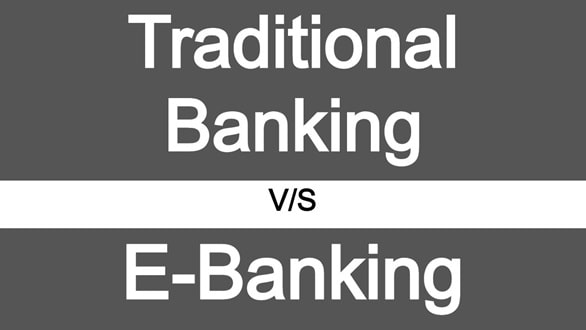When you look at the finance sector, particularly at how banking is done, that thing has changed significantly in the last two decades or so, right? And that must be the reason why you may be hearing a lot about this new thing called E-Banking. But whenever you hear about it, your mind goes like: Is it any better than the traditional way of banking? Well, that’s a question that matters the most when it comes to banking because you know, everyone wants to see their money growing and safe. And if that’s what you are currently confused about and want to make your mind clear, then you should keep on reading this post until the very end. Why, though? Well, we are about to go down deep and talk about the actual key differences between traditional banking and E-Banking. So yeah, here we go now.
Traditional Banking
When we talk about the old-school way banks used to run, we’re hitting on what’s called Traditional Banking. This is the classic setup where you’d actually have to walk into a bank, see people face-to-face, and get your banking done. Yeah, it means dealing with real humans for your deposits, withdrawals, or just crying over your account balance, you know? It’s all about those in-person chats and paper flying everywhere.
E-Banking
Now, flip the script, and you’ve got e-Banking, or what the cool kids might call Electronic Banking. This is where the internet has become your best banking buddy. Instead of stepping foot in a bank, you’re tapping away on your phone or clicking through on a website. Need to move some cash at 3 AM? No problem. Wanna check if you can afford that late-night online shopping spree? Easy. It’s banking on your terms, whenever and wherever you feel like it, and that’s how it is nowadays.
| Aspect | Traditional Banking | E-Banking |
|---|---|---|
| Accessibility | Typically involves visiting physical branches or ATMs for transactions, which may have limited hours. | Accessible 24/7 from anywhere with internet connectivity, through computers or mobile devices. |
| Transaction Speed | Transactions may take longer due to manual processing and physical paperwork. | Transactions are processed instantly or within a few minutes, as they are done electronically. |
| Customer Interaction | In-person customer service is available for inquiries, issue resolution, and account management. | Interaction often occurs through online chat, email, or phone, with limited face-to-face interaction. |

Comparison Between Traditional Banking And e-Banking
1. Getting to Your Cash
So, the biggest thing you’ll notice between old-school banks and e-banking? It’s all about how easy it is to get to your money. With traditional banks, you gotta physically show up at their branches, which is a pain considering their opening times and where they’re located. But e-banking? That’s a whole different ball game. You can check on your cash, move it around, pay bills, basically do your banking thing, anytime, anywhere, as long as you’re hooked up to the internet. This has totally flipped the script on the whole “going to the bank” drama, making handling your money way more chill.
2. Starting an Account
Remember the days of having to go into a bank, stack of papers in hand, just to open an account? Yeah, not fun. Took forever and was kinda a hassle. E-banking’s changed the game here, too. Now, you can kick off an account online in just a few minutes, with just a couple of clicks and barely any paperwork. No need to step inside a bank ever again. This is not just a massive time-saver; it also makes it a breeze for more folks to get started with banking.
3. Fees
Let’s talk about fees for a sec, they’re kinda everywhere in traditional banking. We’re talking monthly fees to keep your account open, fees for using ATMs that aren’t theirs, fees for this, fees for that. A lot of this comes down to the cost of keeping those bank branches running. E-banking’s a lot friendlier on your wallet here. Since they’re not paying for all those physical branches, they can cut out a lot of those annoying fees. A bunch of e-banks even offer accounts with zero fees. That means no more paying just to access your own money at an ATM or keeping your account ticking over.
4. Making Your Money Grow
And here’s where it really matters, making your money work for you. Traditional banks? Yeah, they’re a bit stingy aka ungenerous with the interest rates on your savings, thanks to all the costs they’ve got. E-banking’s where it’s at if you wanna see your savings stack up faster. They’ve got lower costs to worry about, so they can offer you better rates on your savings. That means choosing e-banking could make your money-saving efforts a bit more worth it.
5. Talking with Someone in Person
Alright, so here’s where the old-school banks really shine. You know how sometimes you just wanna talk to someone face-to-face, especially when your money’s on the line? That’s something you can do at traditional banks. Walk into any branch, and boom, you can chat with a real person about whatever’s bugging you. With e-banking, though, you’re kinda stuck with chatting online or maybe a phone call. Sure, lots of online banks are pretty good at helping out, but not being able to see someone in person? That’s a deal-breaker for folks who dig personal touches in their banking.
6. Getting Cash Without the Extra Fees
Now, let’s talk about getting your hands on some cash. The cool thing with traditional banks is they’ve got ATMs everywhere, and you don’t gotta pay extra to use them. E-banks? Well, they don’t have their own ATMs, but they’re smart. They team up with others or even pay you back for any annoying fees if you use an ATM outside their network. So, yeah, you can still get cash pretty easily without it costing you.
7. The Techy Stuff
When it comes to tech, e-banking is killing it. They’re all about making banking smooth and hassle-free right from your phone. Think about doing everything online, like depositing checks with a snap of a photo or getting alerts the second something happens with your account. Traditional banks are kinda trying to keep up, but e-banks are where it’s at for the cool features and easy use.
8. Keeping Your Money Safe
Both types of banking are super serious about security because, obviously, nobody wants their money to go poof. But with e-banking, you’ve gotta be a bit more on your toes. We’re talking strong passwords, that extra step of verification, and watching out for sneaky scams in your inbox.
Conclusion
That’s pretty much it for today. Now, you can decide for yourself whether or not this E-Banking thing is for you, or do you want to just stick to the old-school way of banking, you know? We really hope that our today’s post has served you well, and led you to make an informed decision of your own.

Meet Suhas Harshe, a financial advisor committed to assisting people and businesses in confidently understanding and managing the complexities of the financial world. Suhas has shared his knowledge on various topics like business, investment strategies, optimizing taxes, and promoting financial well-being through articles in InvestmentDose.com


